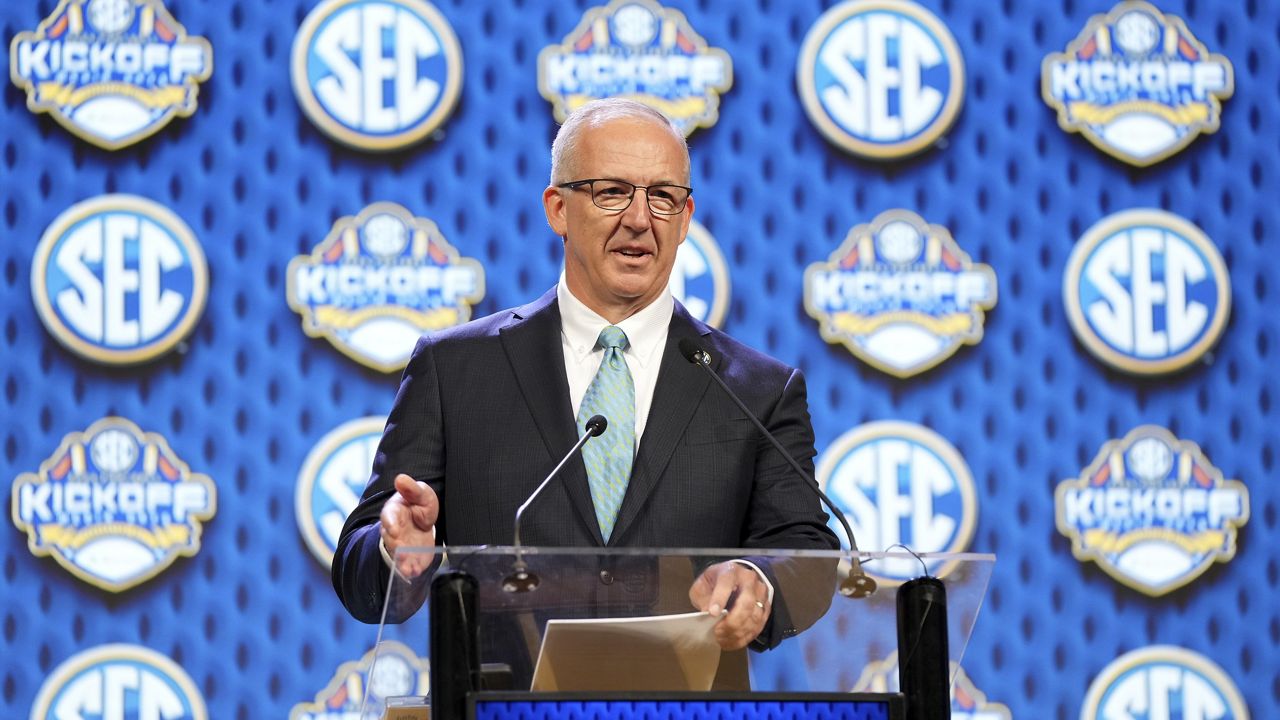DALLAS — Southeastern Conference Commissioner Greg Sankey unofficially opened the league’s first football season as 16-team league Monday in a massive hotel ballroom in North Texas, a new setting for SEC Media Days at a time when everything about college sports seems in flux.
“It’s time to update your expectations for what college athletics can be,” Sankey said, kicking off the four-day event.
The powerhouse SEC, which boasts 13 college football national champions since 2006, now includes Texas and Oklahoma. It’s one of many changes going into effect this year in college football, with plenty more to come.
“We as leaders are responsible for navigating what really are for us in college sports uncharted waters of change,” Sankey said.
The 59-year-old commissioner stressed that college sports must find solutions from within while also recognizing external pressures from lawsuits and politicians that complicate the situation.
“But the reality is there is no easy button we can just go push to resolve the issues we face. There’s no magic pill. Anytime you go through a reset, it is difficult,” Sankey said.
Maybe the most dramatic changes are still coming together. In late May, the NCAA and power conferences agreed to the framework of a settlement of several antitrust lawsuits. The settlement includes $2.8 billion in damages to be paid out by the NCAA and a groundbreaking commitment by the conferences to allow its schools to share a percentage of athletic revenue with their athletes.
A full term sheet with details of the settlement still must be filed with the federal court in Northern California that is overseeing the case. That is expected to happen soon. Then it must be approved by Judge Claudia Wilken.
“We are literally working to make what would normally be a decade’s worth of change in a matter of months,” Sankey said.
Sankey said additional revenue streams will be needed, but he warned of college sports leaders handing over control in exchange for money, a not-so-subtle allusion to private equity.
“We’ve been incredibly successful, and I understand why so many outside of the campus and conference realm are interested in coming in and being a part of it, but that responsibility lies with us to bring people into the solution, not to cede authority to external actors,” Sankey said.
Big enough?
Early in about a 30-minute opening statement, Sankey dropped a line that gained some traction on social media and led to a few follow-up questions.
“Sixteen is our today, and 16 is our tomorrow,” he said, referring to the size of the newly expanded conference.
After three years of tumultuous and transformative conference realignment, there has been relative peace on that front in 2024. But instability in any conference fuels speculation.
In the Atlantic Coast Conference, Florida State and Clemson have sued the league, challenging the agreements the bind schools to the league with hundreds of millions of dollars in potential exit fees and penalties.
Sankey clarified that his interest in the ACC litigation is only as an observer.
“As I said, we’re focused on our 16. I’ve said before at Media Days, I’m not a recruiter,” he said. “Our presidents have been clear that I am not going to entangle us in litigation around expansion. So I pay attention, but I’m not engaged in those conversations.”
Sankey was asked to clarify 16 today, 16 tomorrow. Was that a reference to long-term future of the SEC?
“So the last three questions are a part of the reality, which is I’ve responded now three times where our focus lies. Our focus is on our 16 members. I have a responsibility to pay attention, and I’m certainly not going to fuel speculation on what happens next,” he said.
“We can certainly remain at 16 for a long, long time and be incredibly successful.”
As a result of massive realignment, the Big 12 has 16 teams, the Big Ten 18 and the ACC now has schools in Dallas and the California Bay Area. The Pac-12 is a two-team league, fighting for survival.
Texas and Oklahoma deciding to move to the SEC was the first domino to fall in 2021, a move that doesn’t look quite so radical in comparison to other that followed.
“We know who we are, and the Southeastern Conference, we’re the one conference at this level where the name still means something, the southeastern part of the United States, where when we expanded, we actually restored historic rivalries while adding only 100 miles to the longest campus-to-campus trip our student-athletes will experience,” Sankey said.



